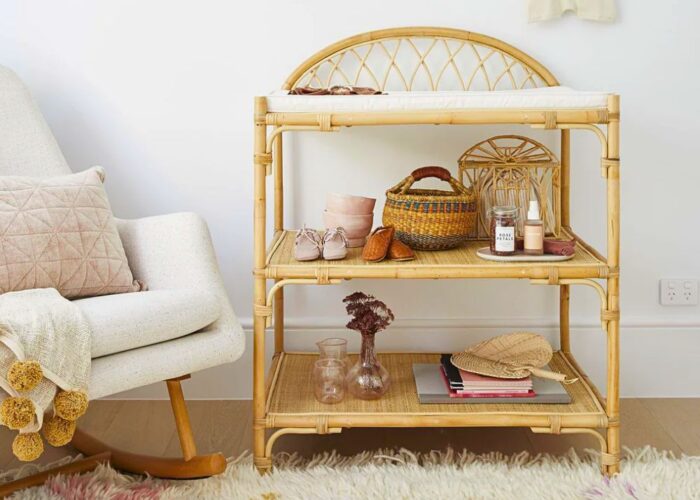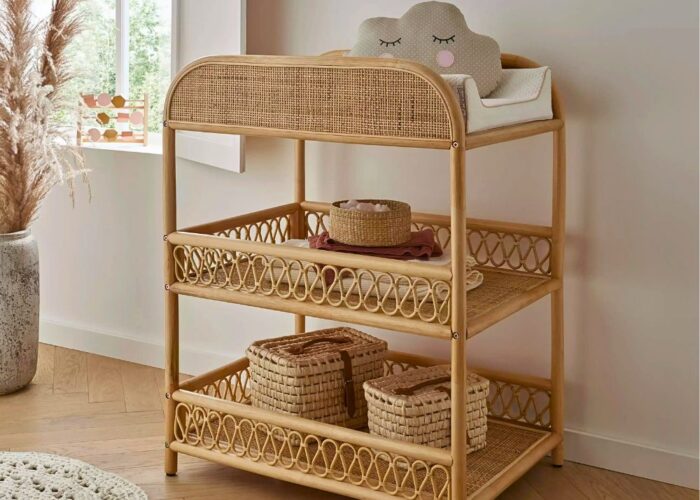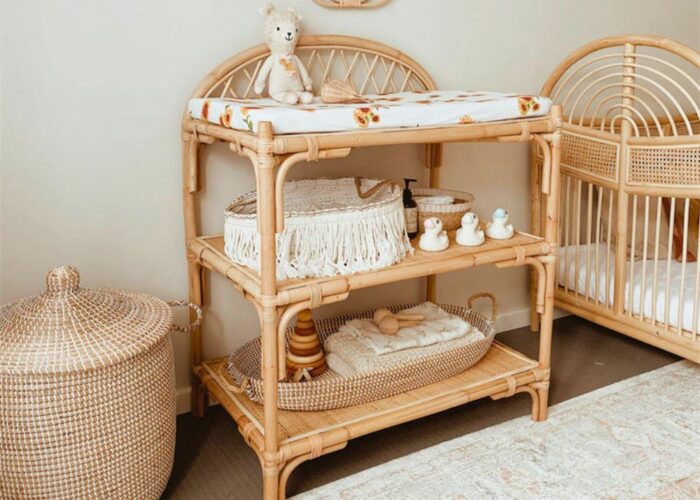Organizing a changing table is essential for efficient and stress-free baby care routines. A well-organized changing table not only streamlines the process of diaper changes but also provides a calm and welcoming environment for both parents and babies. This article will guide you through how to organize a changing table and help you create a functional and tidy changing table setup that meets the needs of both you and your little one.
Contents
1. Assessing Your Space
Before organizing your changing table, it’s vital to evaluate your space and choose the right furniture piece to suit your needs. Whether you have ample room or are working with a compact area, thoughtful decisions about your changing table setup can optimize functionality and convenience. Here’s how to begin:
- Evaluating Available Space:
Start by assessing the space in your nursery, bathroom, or chosen location for the changing table. Measure dimensions, considering height, width, and depth to ensure a comfortable fit without obstructing walkways or other furniture. Consider room layout, traffic flow, and proximity to essentials like diapers and wipes. For limited space, explore compact changing table options or alternatives like wall-mounted changing stations or portable pads. Maximize vertical storage with shelves or organizers to optimize small areas.

- Choosing the Right Changing Table:
Once space constraints are clear, select a changing table that meets your needs. Look for:
- Size and Design: Choose a table that complements your decor and fits seamlessly into your space, whether standalone, convertible, or combo styles.
- Storage Features: Opt for ample storage options such as shelves, drawers, or cabinets to keep essentials organized and accessible. Adjustable features accommodate items of varying sizes.
- Safety Considerations: Prioritize sturdy construction, rounded edges, and safety straps to secure your baby during changes. Seek tables meeting safety standards and certifications.
- Versatility: Select a table with dual-purpose functionality, like a dresser or storage unit, to maximize space and value as your child grows.
2. Essential Supplies
Setting up a changing station requires careful consideration of essential supplies to ensure smooth and efficient diaper changes. Here are some must-have items:
- Diapers and Wipes:
Stock up on an ample supply of diapers in various sizes to accommodate your baby’s needs as they grow. Keep a stash of wipes handy for quick and easy cleanup during diaper changes. Choose wipes that are gentle on your baby’s skin and free from harsh chemicals.
- Diaper Pail or Disposal System:
Invest in a diaper pail or disposal system to contain and eliminate odors from used diapers. Look for a pail with a secure lid and odor-blocking features to keep your nursery smelling fresh. Consider options with hands-free operation for added convenience.

- Changing Pad and Covers:
Provide a comfortable and hygienic surface for diaper changes with a soft changing pad. Choose a waterproof and easy-to-clean pad that fits securely on top of your changing table or dresser. Stock up on washable covers to keep the pad clean and fresh between changes.
Keep a bottle of hand sanitizer nearby to clean your hands before and after diaper changes, especially when soap and water are not readily available. Have a tube or jar of diaper rash cream on hand to soothe and protect your baby’s skin from irritation. Opt for a product that is hypoallergenic and free from ingredients that may exacerbate diaper rash.
3. Decluttering Your Changing Table
Decluttering your changing table is a crucial step in maintaining a functional and organized baby care area. Here’s how to declutter your changing table effectively:
- Assess Current Setup: Take a close look at your changing table and assess the current state of organization. Identify any items that are cluttering the space or hindering your ability to access essentials quickly during diaper changes.
- Sort Through Supplies: Remove all items from the changing table and sort them into categories such as diapers, wipes, creams, and other baby care essentials. This step helps you gain a clear understanding of what you have and what you need to keep.
- Purge Unnecessary Items: Get rid of any expired, unused, or redundant items that are taking up valuable space on your changing table. Dispose of expired products and donate or pass on items that your baby has outgrown or no longer requires.
- Organize Essentials: Once you’ve decluttered your changing table, organize the essentials in a way that makes them easily accessible during diaper changes. Consider using storage bins, baskets, or drawer dividers to keep items neatly organized and within reach.
- Maintain Regularly: Make decluttering and organizing your changing table a regular part of your baby care routine. Regular maintenance ensures that the changing table remains clutter-free and functional, making diaper changes quicker and more efficient.
4. Organizational Solutions
To ensure a smooth and efficient baby care routine, organizing your changing area is essential. Here are some effective organizational solutions to consider:
- Drawer Dividers and Organizers: Utilize drawer dividers and organizers to maximize the storage space in your changing table drawers. These tools help separate diapers, wipes, creams, and other essentials, making it easy to locate items quickly during diaper changes. Choose adjustable dividers to customize the layout of your drawers according to your needs.
- Storage Baskets and Bins: Incorporate storage baskets and bins into your changing area to keep larger items neatly contained. Use baskets with handles for easy access, and consider labeling bins to categorize items effectively. Stackable bins can also help maximize vertical space and keep your changing area clutter-free.
Wall-Mounted Shelves: Install wall-mounted shelves above or near your changing table to provide additional storage space for essentials such as diapers, wipes, and creams. This allows you to keep frequently used items within arm’s reach while freeing up valuable tabletop space. Choose shelves with hooks or pegs to hang towels, clothing, or other accessories for added convenience.
5. Maintenance and Cleaning
Keeping your changing table clean and well-maintained is essential for ensuring a smooth and efficient baby care routine. Here are some strategies to maximize your changing table’s efficiency through maintenance and cleaning:
Establishing a Routine:
Set a regular schedule for cleaning and maintaining your changing table. This routine can include tasks such as wiping down surfaces, restocking supplies, and laundering changing pad covers. By establishing a consistent schedule, you can ensure that your changing table remains clean and organized at all times.

Tips for Keeping It Tidy:
- Organize supplies: Use drawer dividers, storage baskets, and bins to keep diapers, wipes, creams, and other essentials neatly organized and easily accessible.
- Wipe down surfaces: Regularly clean and disinfect the changing table surface to remove germs and bacteria. Use baby-safe cleaning products or a mixture of mild soap and water to wipe down the surface thoroughly.
- Launder changing pad covers: Wash changing pad covers regularly to maintain cleanliness and hygiene. Keep a spare cover on hand to use while the other is being washed.
- Empty diaper pail regularly: Dispose of used diapers promptly to prevent odors from lingering in your changing area. Empty and clean the diaper pail as needed to keep it fresh.
6. Personalizing Your Setup
Personalizing your changing table setup not only adds a unique touch to your baby’s nursery but also enhances its functionality and aesthetic appeal. Here’s how to personalize your changing table setup:
- Adding Personal Touches: Incorporate items that reflect your personal style and preferences. Consider adding decorative elements such as framed photos, artwork, or personalized wall decals to personalize the space. You can also choose changing pad covers and storage baskets in colors or patterns that complement the nursery decor.
- Making It Functional: Customize your changing table setup to meet your specific needs and preferences. Arrange essential items such as diapers, wipes, creams, and changing pad covers in a way that makes them easily accessible during diaper changes. Use drawer dividers, storage bins, and baskets to keep supplies organized and within reach. Additionally, consider adding accessories such as a diaper caddy or organizer to hold frequently used items.
- Aesthetically Pleasing: Pay attention to the overall design and aesthetics of your changing table setup. Choose furniture pieces and accessories that harmonize with the nursery decor and create a cohesive look. Opt for quality materials and finishes that are both durable and visually appealing. Incorporate soft lighting, decorative accents, and textiles such as curtains or rugs to create a warm and inviting atmosphere.
7. FAQs
7.1 Are changing tables sanitary?
Changing tables can be sanitary if they are cleaned and maintained properly. Regular cleaning and disinfection of the changing table surface, as well as washing or replacing changing pad covers regularly, can help prevent the spread of germs and bacteria. Additionally, using a diaper pail with a tight-fitting lid and emptying it regularly can help minimize odors and maintain cleanliness. It’s important to follow proper hygiene practices, such as washing your hands before and after diaper changes, to further reduce the risk of contamination.
7.2 Where is the best place to put a changing table?
The best place to put a changing table is in a convenient and easily accessible location within your home. Many parents choose to place the changing table in the nursery or baby’s room for quick access during diaper changes. However, if space is limited, you can also consider placing the changing table in a bathroom or another area where you spend a significant amount of time with your baby. It’s important to choose a location that is safe, well-lit, and free from hazards. Additionally, ensure that the changing table is placed on a stable and level surface to prevent accidents.
7.3 Can I use a dresser as a changing table?
Yes, you can use a dresser as a changing table. Many parents opt to repurpose a dresser by adding a changing pad to the top surface, creating a functional and space-saving changing area. To ensure safety and convenience, choose a dresser with a flat and stable top surface that is large enough to accommodate a changing pad securely. Additionally, consider adding safety straps or securing the changing pad to the dresser to prevent it from sliding or shifting during diaper changes. Using a dresser as a changing table can be a practical and versatile solution, especially if you have limited space in your nursery or baby’s room.
7.4 How many newborn diapers do I need?
The number of newborn diapers you’ll need can vary depending on factors such as your baby’s size, how often you plan to change diapers, and whether you’re using disposable or cloth diapers. On average, newborns go through about 8 to 12 diapers a day during the first few weeks. It’s a good idea to have at least one to two packs of newborn diapers on hand before your baby arrives. This typically equates to around 150 to 300 diapers, but having extras can provide peace of mind, especially in the early days when diaper changes are frequent. As your baby grows, their diaper usage may decrease, so you can adjust your diaper stockpile accordingly.
7.5 How often should I restock diapers and wipes?
When caring for a newborn, stocking up on diapers and wipes is crucial. On average, a baby may need to be changed 6 to 10 times a day, with each diaper change requiring the use of 2 to 3 wipes. This means you may need approximately 42 to 70 wipes for diaper changes alone in a week. Additionally, having extra wipes on hand for unexpected situations is essential. Therefore, monthly stocking of wipes can range from 2400 to 3600 wipes depending on the specific needs of the baby and the family’s usage habits. As for diapers, you’ll also need to consider the number of diapers used per day and the size of the diaper pack you purchase to ensure you never run out when needed.
If you have any further questions, don’t hesitate to send thanhcongcraft an email us at info@thanhcongcraft.com or message us at WhatsApp: +84967485411. Hope to serve you soon! Best regard!












